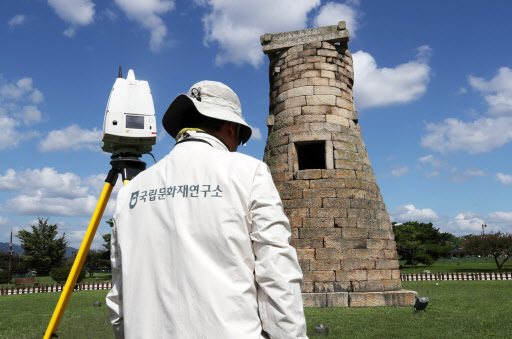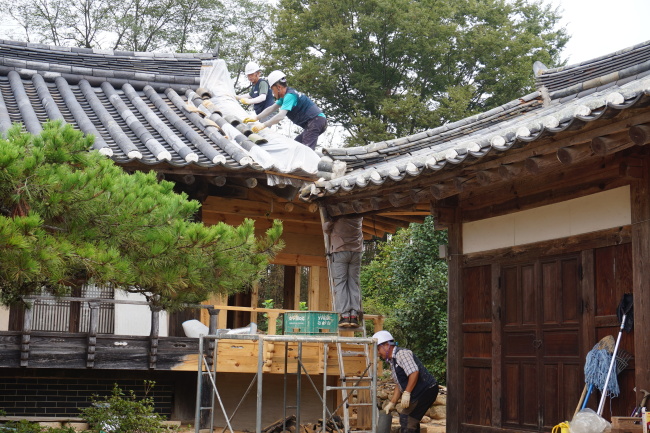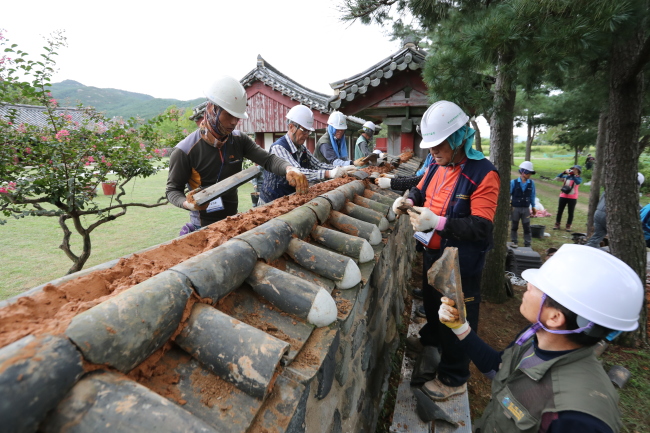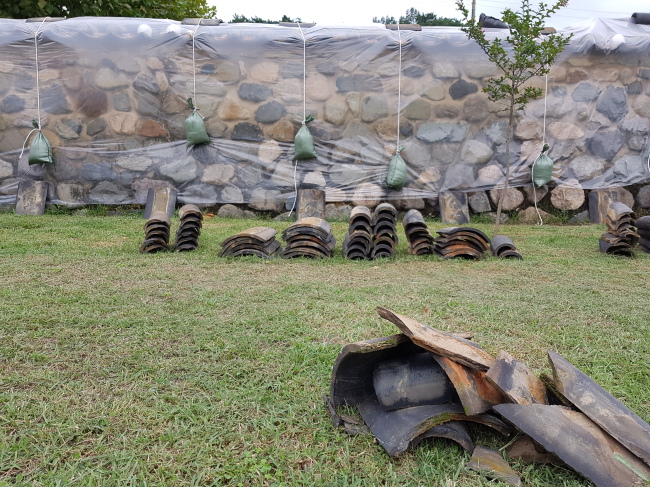Gyeongju strives to protect artifacts after quake
Authorities scramble to assess full scope of damages, conduct emergency repairs amid lack of integrated monitoring system
By Rumy DooPublished : Sept. 20, 2016 - 17:36
GYEONGJU, North Gyeongsang Province -- Over 60 historical sites in southeast Korea, including national treasures Bulguksa Temple and Cheomseongdae Observatory, were found to be damaged after a magnitude 5.8 earthquake shook the historical city of Gyeongju last Monday, followed by over 400 aftershocks -- the largest of which occurred Monday evening measuring 4.5 on the Richter scale.
The Cultural Heritage Administration, the Gyeongju city government and a number of relevant organizations are scrambling to assess the full scope of the damage at the numerous temples and historical sites around Buji-ri, Naenam-myeon in North Gyeongsang Province, the epicenter of the quake located in southern Gyeongju. For now, the damage consists mostly of fallen giwa, or traditional roof tiles, and cracks on walls. However, experts are raising concerns about historical artifacts’ exposure to potential disasters.
The Cultural Heritage Administration, the Gyeongju city government and a number of relevant organizations are scrambling to assess the full scope of the damage at the numerous temples and historical sites around Buji-ri, Naenam-myeon in North Gyeongsang Province, the epicenter of the quake located in southern Gyeongju. For now, the damage consists mostly of fallen giwa, or traditional roof tiles, and cracks on walls. However, experts are raising concerns about historical artifacts’ exposure to potential disasters.

Current status of damage: Leaning tower, fallen parts
Some 60 historical sites were damaged during the quake, the Cultural Heritage Administration announced Sunday.
On Tuesday morning, the state agency in charge of historical artifacts said that Monday evening’s aftershock, which occurred in southeastern Gyeongju, appeared to have caused no additional damage.
The previously announced damage includes fallen giwa from the roof of the Main Buddha Hall (Daewoongjeon) of Bulguksa Temple, which was temporarily repaired over the weekend, and a displaced banister on the temple’s Dabotap Pagoda (National Treasure No. 20).
The Buddhist temple, located in southeastern Gyeongju and built in 774 during the Silla Kingdom (57 B.C. to 935), was designated a UNESCO World Heritage in 1995 alongside the nearby Seokguram Grotto, which is reported to be unharmed.
Cheomseongdae Observatory, which is National Treasure No. 31 and considered Asia’s oldest extant astronomical observatory, has leaned 2 centimeters farther northward after the quake, while a gap on its upper stone has widened by 5 centimeters. A survey in 2014 found the tower, situated in central Gyeongju, to be inclining 20.4 centimeters northward from its original position.

Some academics have suggested disassembling and reassembling the 9.07-meter tall cylindrical granite block tower after the discovery of cracks, displacement of stones and discoloration in 2014. It has since been inspected four times a year by the National Research Institute of Cultural Heritage. According to a report last year, some 30 parts of the tower show damage, while its northern base continues to sink.
Despite the damage, the tower’s sturdy design allows it to withstand quakes and even severe weathering, said Kim Deok-moon, who is in charge of architectural heritage at the research institute.
A team from the research institute began a detailed inspection of the observatory site Tuesday morning. Plans for restoration work on Cheomseongdae and other earthquake affected sites will be decided following the inspection.
Other major damage includes cracks on Bunhwangsa Temple’s Mojeonseoktap stone pagoda (National Treasure No. 30), in central Gyeongju.
No artifacts were harmed at the Gyeongju National Museum, which is home to over 100,000 artifacts including Silla-period golden crowns and Buddhist sculptures, the museum said Tuesday. Four window panels at the museum’s Archaeology Hall shattered and some of its outer wall tiles fell off, but the artifacts, most of them having been fastened to their display cases in preparation for possible earthquakes, remained unharmed, the museum said.
Of the museum’s three buildings, only the Art Hall, built in 2002, was constructed to withstand earthquakes. The main Archaeology Hall, which contains the most number of artifacts, was built in 1975 before mandatory earthquake proof measures were implemented in 1988. Reinforcement work was conducted on the building in 2013 after the structure failed a stress test in 2011, the museum said.
In and around Gyeongju, a group of workers specializing in the preservation of historical artifacts -- partially supported by the Cultural Heritage Administration -- has been playing an active part in carrying out emergency repairs on minor fractures. As of Monday, a team of over 40 people is restoring fallen tiles at the Yangsanjae Shrine and the Joseon era nobility’s residence, Chunguidang, both located in southern Gyeongju.

About a quarter of the roof tiles on the four walls enclosing Yangsanjae Shrine have been damaged. Restoration is estimated to take at least one week or more, said Jin Byung-gil, the group’s leader.
The team will later conduct repair works at some 30 sites including the Sungdeokjeon Shrine at the Gyeongju Oreung Royal Tombs, and the Joseon era dwelling Wolamjae. Last week, it completed emergency rainproof measures on some 17 sites, it said.
Culture Minister Cho Yoon-sun, head of the Culture Heritage Administration Na Sun-hwa and other related officials visited Gyeongju on Tuesday afternoon to assess the damage and discuss future steps. Some 2.3 billion won ($2.04 million) will be allocated as emergency repair funds, the Cultural Heritage Administration announced last week.

Lack of artifact management system
Some experts highlight the need for an integrated database on the damage and repair of important historical sites. A 2013 Seoul National University report recommended the National Research Institute of Cultural Heritage to implement such a system to manage risks stemming from natural disasters and to record regular repairs. The project has been put on hold indefinitely, however, due to insufficient funds, according to reports. The SNU report also cautioned about the increasing number of earthquakes in the Gyeongju and Gunsan areas.
During an earthquake stress test conducted in 2013, some 30 out of 152 stone artifacts in Korea, including towers, bridges and pagodas, were assessed as “at risk” of damage, the Cultural Heritage Administration was reported as saying last week. Only 23 were deemed “safe,” while 99 received an “average” rating.
By Rumy Doo (doo@heraldcorp.com)


![[Exclusive] Korean military set to ban iPhones over 'security' concerns](http://res.heraldm.com/phpwas/restmb_idxmake.php?idx=644&simg=/content/image/2024/04/23/20240423050599_0.jpg&u=20240423183955)

![[Graphic News] 77% of young Koreans still financially dependent](http://res.heraldm.com/phpwas/restmb_idxmake.php?idx=644&simg=/content/image/2024/04/22/20240422050762_0.gif&u=)



![[Pressure points] Leggings in public: Fashion statement or social faux pas?](http://res.heraldm.com/phpwas/restmb_idxmake.php?idx=644&simg=/content/image/2024/04/23/20240423050669_0.jpg&u=)









